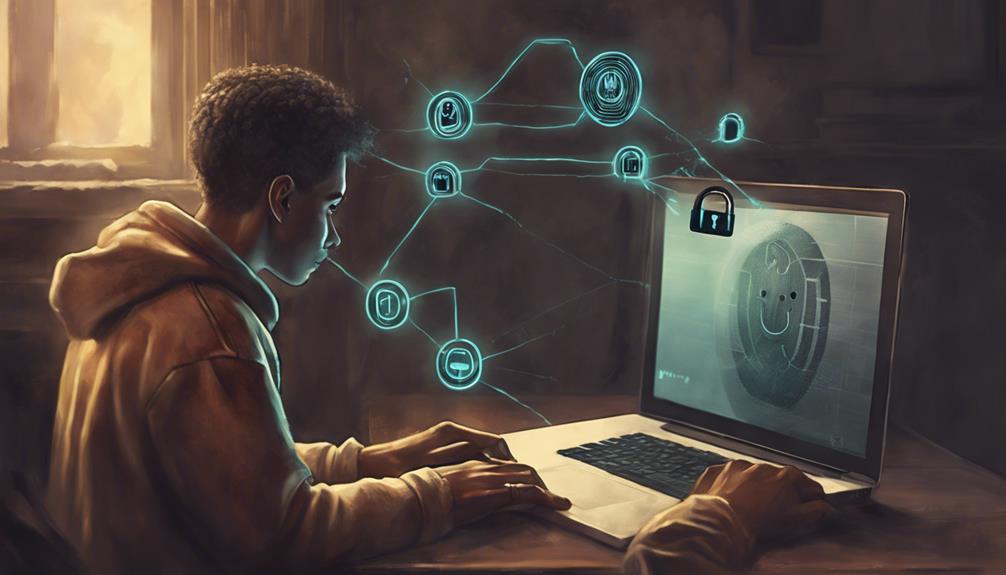Wi-Fi networks are not entirely safe from hackers due to vulnerabilities that can be exploited for unauthorized access. Common techniques include default router credentials and firmware vulnerabilities. To secure your network, change admin credentials, update firmware, and use encryption like WPA2 and WPA3. Signs of a hack include slow internet, unusual activity, and unexpected browser redirects. If hacked, change passwords, reset the router, and consider a VPN. Follow best practices by updating firmware, using strong passwords, and disabling remote management. Understanding Wi-Fi vulnerabilities is key to safeguarding your network against cyber threats and data breaches.
Key Takeaways
- Wi-Fi can be safe if secure measures like strong encryption (WPA2/WPA3) and regular updates are implemented.
- Regularly changing default admin credentials and disabling remote management enhances Wi-Fi security.
- Monitoring network activity for unusual behavior helps detect potential hacking attempts.
- Utilizing a Virtual Private Network (VPN) adds an extra layer of security to Wi-Fi networks.
- Promptly addressing any signs of a hacked network, such as unusual activity or password changes, is crucial.
Common Wi-Fi Hacking Techniques
Various malicious tactics are employed by hackers to compromise Wi-Fi networks, posing significant security risks to users. Common Wi-Fi hacking techniques include exploiting default credentials on routers, allowing remote access to one in every 16 home Wi-Fi networks.
Hackers often target firmware vulnerabilities in Wi-Fi routers, exploiting unpatched flaws to gain unauthorized access. DNS hijacking is another prevalent technique used by hackers, redirecting network traffic to malicious websites without users' knowledge.
Additionally, Wi-Fi Protected Setup and Universal Plug and Play features can be exploited by cybercriminals to infiltrate networks. Manufacturers release firmware updates to address known vulnerabilities and enhance the security settings of Wi-Fi routers.
It is essential for users to stay vigilant, regularly update their firmware, and secure their networks to mitigate the risks associated with these hacking techniques.
Steps to Secure Your Wi-Fi Network

Hackers employ various malicious tactics to compromise Wi-Fi networks, making it imperative for users to implement robust security measures to protect their network integrity.
To secure your Wi-Fi network effectively, follow these key steps:
- Change default admin credentials: Default passwords make routers vulnerable. Changing them can prevent unauthorized access.
- Update router firmware: Regular updates address vulnerabilities, enhancing security and reducing hacking risks.
- Disable remote administration: By limiting remote access, you can prevent unauthorized individuals from controlling your network.
- Use WPA2 encryption: Employing WPA2 or WPA3 encryption protocols guarantees that data transmitted over your network is secure from potential hackers.
Signs of a Hacked Wi-Fi Network

Indicators of a compromised Wi-Fi network can manifest through a range of telltale signs that users should be vigilant about detecting.
Slow internet speed and unusual network activity are common red flags that may suggest a Wi-Fi hacking incident. Additionally, unauthorized software installations and changes in device behavior could indicate a breach in your network security.
Rerouting to unfamiliar websites, unexpected browser redirects, and DNS settings tampering leading to suspicious network behavior are also signs of a hacked Wi-Fi network. Moreover, password changes without your knowledge and the presence of unrecognized devices on your network should raise concerns about a potential hack.
It is important to stay alert to these signs to promptly address any security vulnerabilities and safeguard your network from unauthorized access. Regular monitoring and immediate action upon noticing these signs can help mitigate the risks associated with a compromised Wi-Fi network.
Recovering From a Wi-Fi Hack

To recover from a Wi-Fi hack, immediate actions such as changing your Wi-Fi network password and resetting your router to factory settings are essential steps in regaining control over your compromised network security.
In addition to these important steps, updating your router's firmware to address any vulnerabilities exploited by hackers is paramount.
Monitoring your network for any unusual activity is also critical to detect ongoing hacking attempts and prevent further breaches.
Furthermore, considering the use of a Virtual Private Network (VPN) can provide an extra layer of encryption and security when accessing your Wi-Fi network, enhancing your overall protection against potential security threats.
- Change your Wi-Fi network password promptly.
- Reset your router to factory settings to eliminate any malicious software.
- Update your router's firmware to patch vulnerabilities.
- Monitor network activity for any signs of ongoing hacking attempts.
Best Practices for Wi-Fi Security

Enhancing Wi-Fi security involves implementing a combination of proactive measures to safeguard against potential cyber threats and unauthorized access. One of the fundamental steps is to change default admin passwords on routers, which can prevent remote access by hackers.
Enabling WPA2 encryption on Wi-Fi networks adds an important layer of security, preventing unauthorized access to sensitive information. Regularly updating router firmware is essential as it helps patch known vulnerabilities and guarantees network security.
Disabling remote management on routers is another effective strategy to prevent unauthorized access and potential hacking attempts. Implementing strong and unique Wi-Fi passwords is vital to deterring hackers from gaining access to your network.
Understanding Wi-Fi Vulnerabilities

Understanding Wi-Fi vulnerabilities is imperative for maintaining a secure network environment and safeguarding against potential cyber threats.
When it comes to Wi-Fi security, there are several key vulnerabilities that users should be aware of:
- Default Credentials: Approximately 1 in 16 home Wi-Fi routers can be remotely accessed using default admin passwords, making them an easy target for hackers.
- Firmware Vulnerabilities: Exploiting unpatched firmware vulnerabilities poses a significant risk to Wi-Fi security, as hackers can leverage these weaknesses to gain unauthorized access to networks.
- Remote Management: Remote access to Wi-Fi routers can provide an entry point for malicious actors if not properly secured, emphasizing the importance of configuring remote management securely.
- Firmware Updates: Manufacturers release firmware updates to address known vulnerabilities and enhance Wi-Fi security. Regularly updating the firmware of Wi-Fi routers is critical in mitigating potential risks and ensuring a more secure network environment.
Safeguarding Your Wi-Fi Network

To safeguard your Wi-Fi network against potential hackers, it is essential to implement secure password protection and regularly update your router's software to patch any known vulnerabilities.
Strong and unique passwords add an additional layer of defense, while firmware updates guarantee that your network remains protected against the latest threats.
Secure Password Protection
Implementing strong and unique passwords for your Wi-Fi network is essential for safeguarding it against potential hackers. To secure your Wi-Fi connection effectively, consider the following measures:
- Utilize a robust password: A complex combination of letters, numbers, and special characters can greatly enhance your network security.
- Enable WPA3 encryption: Upgrading to the latest encryption standard adds a strong layer of protection to your Wi-Fi network.
- Regularly update router firmware: Keeping your router's software up to date helps patch known vulnerabilities that hackers could exploit.
- Disable remote access: By turning off remote access to your router's settings, you minimize the risk of unauthorized entry into your network.
Regular Software Updates
For robust protection against potential cyber threats, maintaining regular software updates on your Wi-Fi router is essential. Updating the software on your Wi-Fi router is vital in safeguarding your network against vulnerabilities and security flaws that hackers often exploit. By regularly installing firmware updates provided by manufacturers, you can effectively enhance the security of your Wi-Fi network and prevent unauthorized access, data breaches, and cyber attacks.
To highlight the importance of regular software updates in protecting your Wi-Fi network, the table below outlines key aspects related to this topic:
| Aspect | Importance |
|---|---|
| Preventing Hackers | Regular updates help prevent hackers from exploiting security flaws. |
| Avoiding Data Breaches | Software updates reduce the risk of unauthorized access and data breaches. |
| Enhancing Security | Firmware updates provided by manufacturers improve the overall security. |
| Targeting Outdated Routers | Hackers often target routers with known vulnerabilities. |
| Minimizing Risk | Up-to-date software reduces the risk of network compromise by hackers. |
Frequently Asked Questions
Can You Get Hacked Through Wi-Fi?
Wi-Fi security vulnerabilities exist, making hacking possible. Default passwords, outdated firmware, and unencrypted data transmission can expose networks. Strengthening security with encryption protocols, regular updates, and unique login credentials is essential. Additional measures like VPNs and firewalls enhance protection.
Can You Check if Your Wi-Fi Is Hacked?
Curious about potential Wi-Fi breaches? Vigilance is key. Regularly monitor your network for unexpected devices, unusual activity, or altered settings. Utilize security logs and scanning tools for thorough assessments. Safeguard your digital domain with diligence.
How Do I Make My Wi-Fi More Secure?
To enhance Wi-Fi security, update router firmware regularly, enforce strong, frequently changed passwords, activate WPA3 encryption, disable remote administration, and monitor network activity. Implementing these measures will bolster protection against unauthorized access and potential hacking threats.
Can Wi-Fi Steal Your Password?
Passwords transmitted over unencrypted Wi-Fi networks can be intercepted by hackers using techniques like packet sniffing. Implementing encryption protocols like WPA3 and avoiding unsecured networks can mitigate the risk of password theft.
Conclusion
To sum up, it is crucial to take proactive measures to safeguard your Wi-Fi network from potential hackers.
By understanding common hacking techniques, securing your network, and recognizing signs of a breach, you can protect your data and privacy.
Remember to stay vigilant and follow best practices for Wi-Fi security to mitigate vulnerabilities and maintain a safe online environment.









